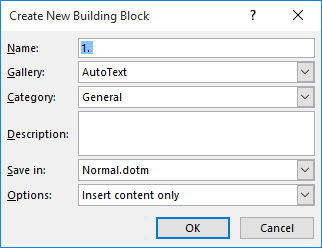Please Note: This article is written for users of the following Microsoft Word versions: 2007, 2010, 2013, 2016, 2019, and 2021. If you are using an earlier version (Word 2003 or earlier), this tip may not work for you. For a version of this tip written specifically for earlier versions of Word, click here: Numbering With Sequence Fields.
Written by Allen Wyatt (last updated July 25, 2020)
This tip applies to Word 2007, 2010, 2013, 2016, 2019, and 2021
Word includes a special sequencing field that you can use to do all sorts of numbering. You can even use the SEQ field to help create broken numbered lists. (A broken numbered list is one in which the flow of the list is interrupted by paragraphs of a different format.) This approach to creating numbered lists is particularly helpful and much less prone to the problems inherent in Word's built-in list numbering. For the purposes of this tip, the format of the sequence field is as follows:
{seq ident}
In this format, ident is replaced with a unique identifier for the sequence in question. Thus, you could have several sequences in a single document. For instance, one numbered sequence could use an identifier of MajorNum1, and another use an identifier of MajorNum2. The identifiers you use are entirely up to you.
You should understand that the sequence field can be much more powerful than implied in this tip. If you want additional information on how it can be used, you should refer to the on-line help for the SEQ field.
When you use the sequence field, and then combine it with the AutoText capabilities of Word, you have a powerful combination for creating numbered lists in your documents. As an example of how you can do this, follow these steps:

Figure 1. The Create New Building Block dialog box.
Now whenever you want to insert the number, type the name you defined in step 7, and then press the F3 key. The field is entered in the document. Note that the number always shows up as 1, but it is updated when you print, or when you select the entire list and press F9.
The process described in this tip works best if you have a single list in your document. Note that the sequence field starts at the beginning of the document and numbers through the whole document, based on the identifier you use. If you are going to have multiple lists in your document, then you can add a second AutoText entry to help with this. The only difference in the above steps is that the SEQ field you define would look like this:
{ seq NumList \r1 }
The addition of the \r1 switch causes Word to start the sequence counter over at 1. You would use this whenever you wanted to start a new list and use the regular field for the rest of your numbered items. (If you want to start the list over at a number other than 1, use the starting number right after \r.)
WordTips is your source for cost-effective Microsoft Word training. (Microsoft Word is the most popular word processing software in the world.) This tip (8180) applies to Microsoft Word 2007, 2010, 2013, 2016, 2019, and 2021. You can find a version of this tip for the older menu interface of Word here: Numbering With Sequence Fields.

Create Custom Apps with VBA! Discover how to extend the capabilities of Office 365 applications with VBA programming. Written in clear terms and understandable language, the book includes systematic tutorials and contains both intermediate and advanced content for experienced VB developers. Designed to be comprehensive, the book addresses not just one Office application, but the entire Office suite. Check out Mastering VBA for Microsoft Office 365 today!
Word doesn't provide a field that allows you to return a word count for a portion of your document, but you can create ...
Discover MoreWhen you create a list using the SEQ field, you may want to create a cross-reference to an item in that field. You can do ...
Discover MoreWhen you use fields to number items within a document, you may want to add some standard text before each field. There ...
Discover MoreFREE SERVICE: Get tips like this every week in WordTips, a free productivity newsletter. Enter your address and click "Subscribe."
2023-10-26 10:22:00
Paul Sauve
Hi,
I have a question about Numbering with Sequence Fields:
i have 2 columns of tickets, one for the customer and a second one to be used for a drawing at the event.
i would like to have the same sequential number twice on each ROW. I would create a table over the tickets which are added as a watermark.
Each row hase 2 fields with the same number.
Is there any way to generate a sequential number the first column from 1 to 100, then repeat for the 2nd column with the same values:
001 001
002 002
003 003
...
Thanks
2023-03-10 10:26:46
Alex
Thank you so much! This is going to save me so much trouble numbering equations on my thesis
Got a version of Word that uses the ribbon interface (Word 2007 or later)? This site is for you! If you use an earlier version of Word, visit our WordTips site focusing on the menu interface.
Visit the WordTips channel on YouTube
FREE SERVICE: Get tips like this every week in WordTips, a free productivity newsletter. Enter your address and click "Subscribe."
Copyright © 2025 Sharon Parq Associates, Inc.
Comments